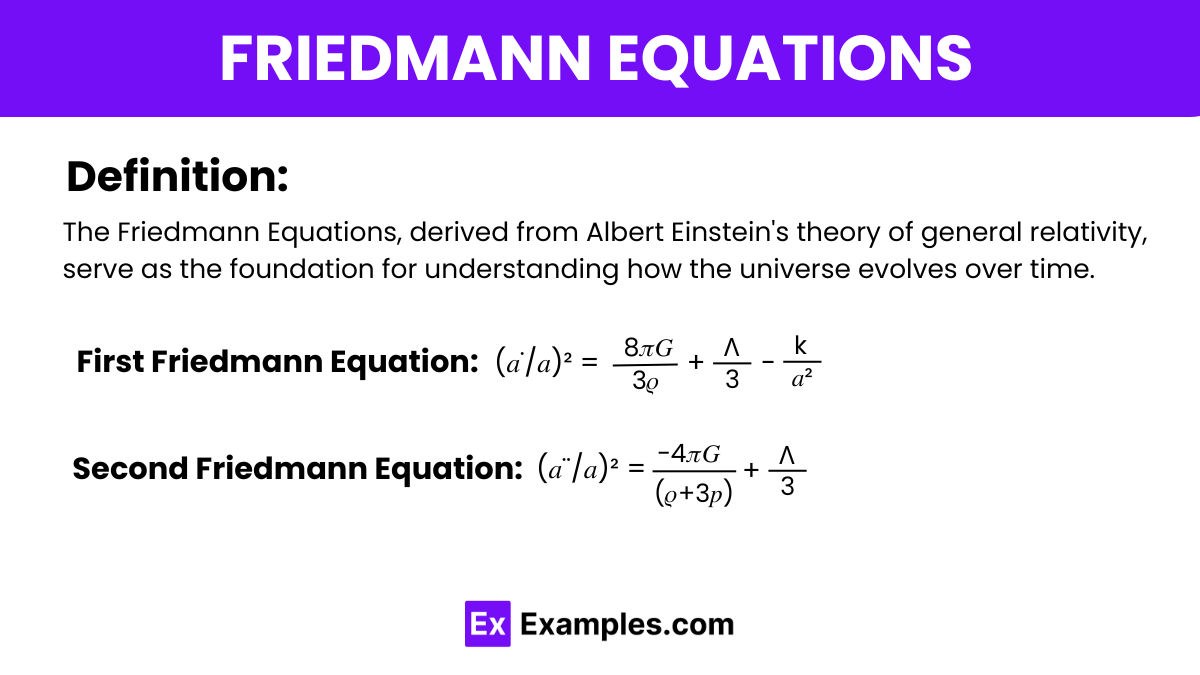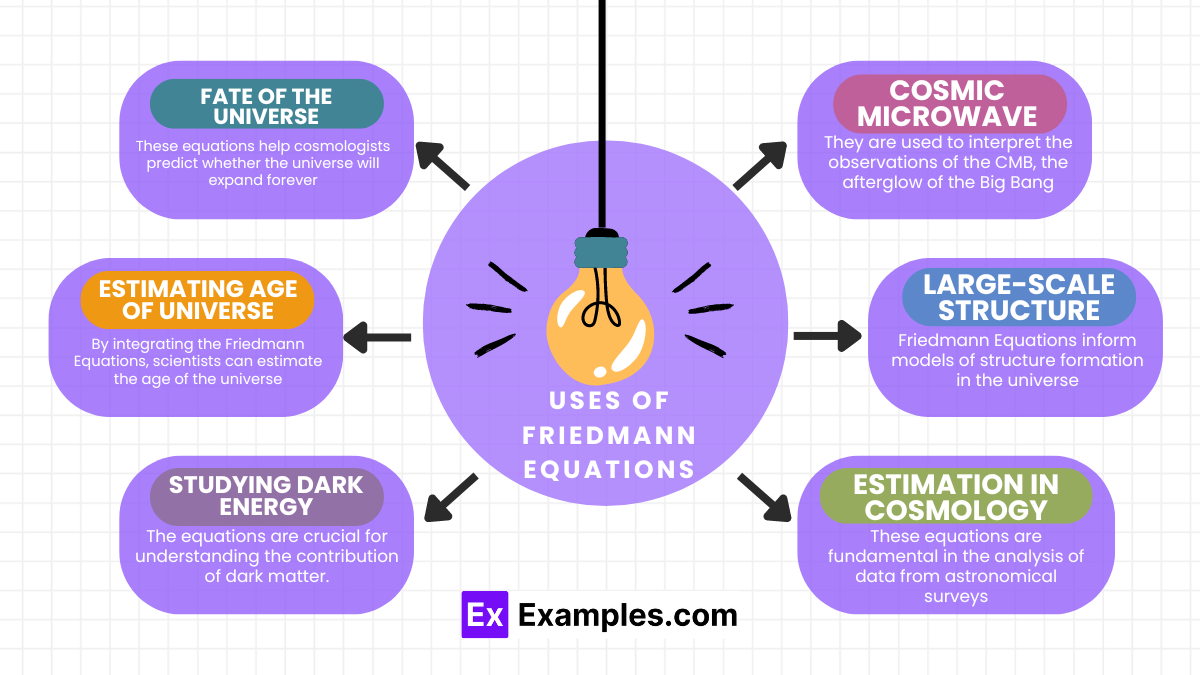The Friedmann equations describe the expansion of:
A black hole
The universe
A star
A galaxy


The Friedmann Equations, fundamental in the laws of cosmology and astrophysics, form the core of modern cosmological models. They describe how the universe expands or contracts over time based on the principles of general relativity. These equations ingeniously link the density of matter and energy in the universe to the rate of expansion, offering a mathematical framework that underpins much of physical cosmology. Thus, they provide critical insights into the dynamics of the universe, aligning with the overarching laws of physics.
The Friedmann Equations are expressed as follows:
First Friedmann Equation:
where:
Second Friedmann Equation:
where:
These equations govern the expansion and dynamics of the universe, allowing cosmologists to model its evolution based on different values of density, pressure, and the cosmological constant.
Step 1: Consider the Universe’s Symmetry
The derivation begins by considering the large-scale structure of the universe, which appears homogeneous (the same at every point) and isotropic (the same in every direction) when viewed on a large scale. This assumption simplifies the general relativity equations significantly because it allows the use of a metric that reflects this symmetry.
Step 2: Apply General Relativity to Cosmology
Einstein’s field equations are the cornerstone of general relativity, linking the geometry of spacetime (expressed through the Einstein tensor) to the energy and momentum within that spacetime (expressed through the stress-energy tensor). In the context of cosmology, these tensors are greatly simplified due to the assumed uniformity of the universe’s contents (like matter, radiation, and dark energy).
Step 3: Use the Robertson-Walker Metric
To make the equations tractable, cosmologists use the Robertson-Walker metric, which incorporates the scale factor—a function that represents how distances in the universe expand or contract over time. This metric helps relate the rate of expansion of the universe to the energy content of the universe.
Step 4: Integrate the Scale Factor
The scale factor’s role is crucial because it helps determine how the volume of the universe changes with time. The rate at which this scale factor changes (its first and second time derivatives) describes how quickly the universe is expanding or contracting, which are the central themes of the Friedmann Equations.
Step 5: Consider Different Forms of Energy
The total energy content of the universe includes matter, radiation, and dark energy, each contributing differently to the overall dynamics. These forms of energy affect the expansion rate differently, which is reflected in the Friedmann Equations. Matter and radiation tend to slow down the expansion due to their gravitational effects, while dark energy, characterized by a negative pressure, accelerates it.

The Friedmann Equations have a wide range of applications in cosmology and astrophysics, enabling deep insights into the structure and evolution of the universe:
The Friedmann Equations are pivotal in cosmology for exploring and explaining the dynamics of the universe. Here are some specific examples of how these equations are applied:
The Friedmann equation describes the universe’s expansion rate, linking it to its matter, radiation, and dark energy content under the framework of general relativity.
The Friedmann model is a cosmological model derived from general relativity that predicts a dynamic, expanding or contracting universe based on its density and energy components.
In general relativity, the Friedmann equation quantifies how the scale factor of the universe evolves over time, influenced by gravitational forces from matter and energy densities.
Text prompt
Add Tone
10 Examples of Public speaking
20 Examples of Gas lighting
The Friedmann equations describe the expansion of:
A black hole
The universe
A star
A galaxy
Which parameter does NOT appear in the Friedmann equations?
Scale factor
Cosmological constant
Hubble parameter
Gravitational constant
The first Friedmann equation relates the Hubble parameter to the:
Density parameter and cosmological constant
Temperature and pressure
Electromagnetic field
Speed of light
Which of the following is a solution to the Friedmann equations?
De Sitter universe
Schwarzschild solution
Kerr metric
Minkowski space
The second Friedmann equation involves the:
Rate of change of the scale factor
Temperature of the universe
Spin of particles
Electric charge
Which term represents the energy density of matter in the Friedmann equations?
Ωₖ
Ωₘ
ΩΛ
Ωᵣ
In the context of the Friedmann equations, ΩΛ represents:
Radiation density
Matter density
Dark energy density
Curvature
The critical density of the universe is defined as the density for which the universe is:
Closed
Open
Flat
Expanding
Which type of universe is described by Ω>1 in the Friedmann equations?
Flat universe
Closed universe
Open universe
Expanding universe
The cosmological constant Λ in the Friedmann equations accounts for:
Radiation
Dark matter
Dark energy
Ordinary matter
Before you leave, take our quick quiz to enhance your learning!

